An Analysis of Fundamental Environmental Law Principles
VerifiedAdded on 2020/02/14
|15
|5999
|1436
Report
AI Summary
This report provides a detailed overview of several core principles within environmental law. It begins with an introduction to environmental law and its importance in protecting scarce natural resources. The report then delves into specific principles, including sustainable development, examining its pillars of economic growth, environmental protection, and social equality. The precautionary principle is discussed, highlighting its role in risk management and decision-making. The integration principle, the substitution principle, the public participation principle, the preventative principle, and the polluter pays principle are also explored, each with their definitions, applications, and significance in shaping environmental regulations and policies. The report draws on legal and economic perspectives to provide a comprehensive understanding of these fundamental concepts. The document is contributed by a student to be published on Desklib.
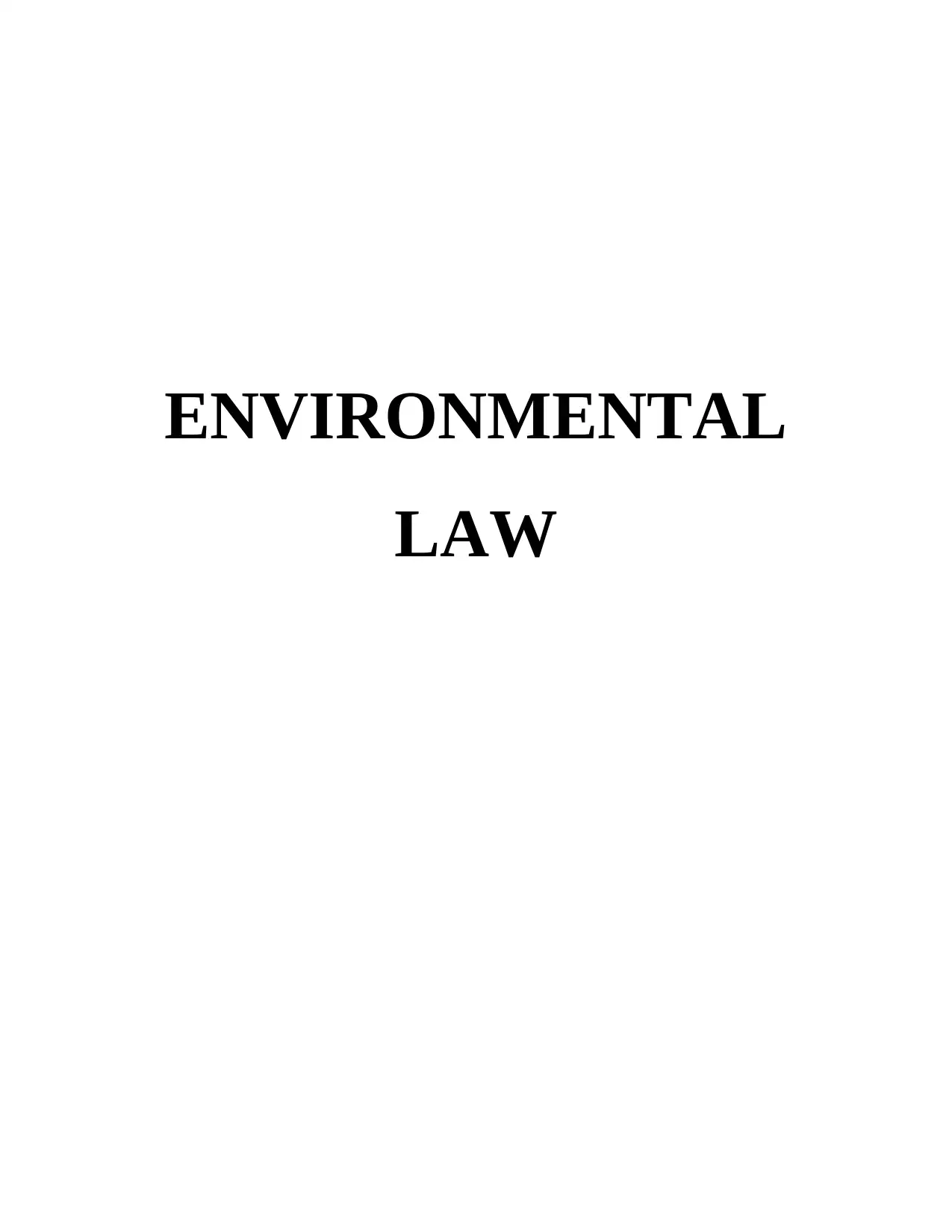
ENVIRONMENTAL
LAW
LAW
Paraphrase This Document
Need a fresh take? Get an instant paraphrase of this document with our AI Paraphraser
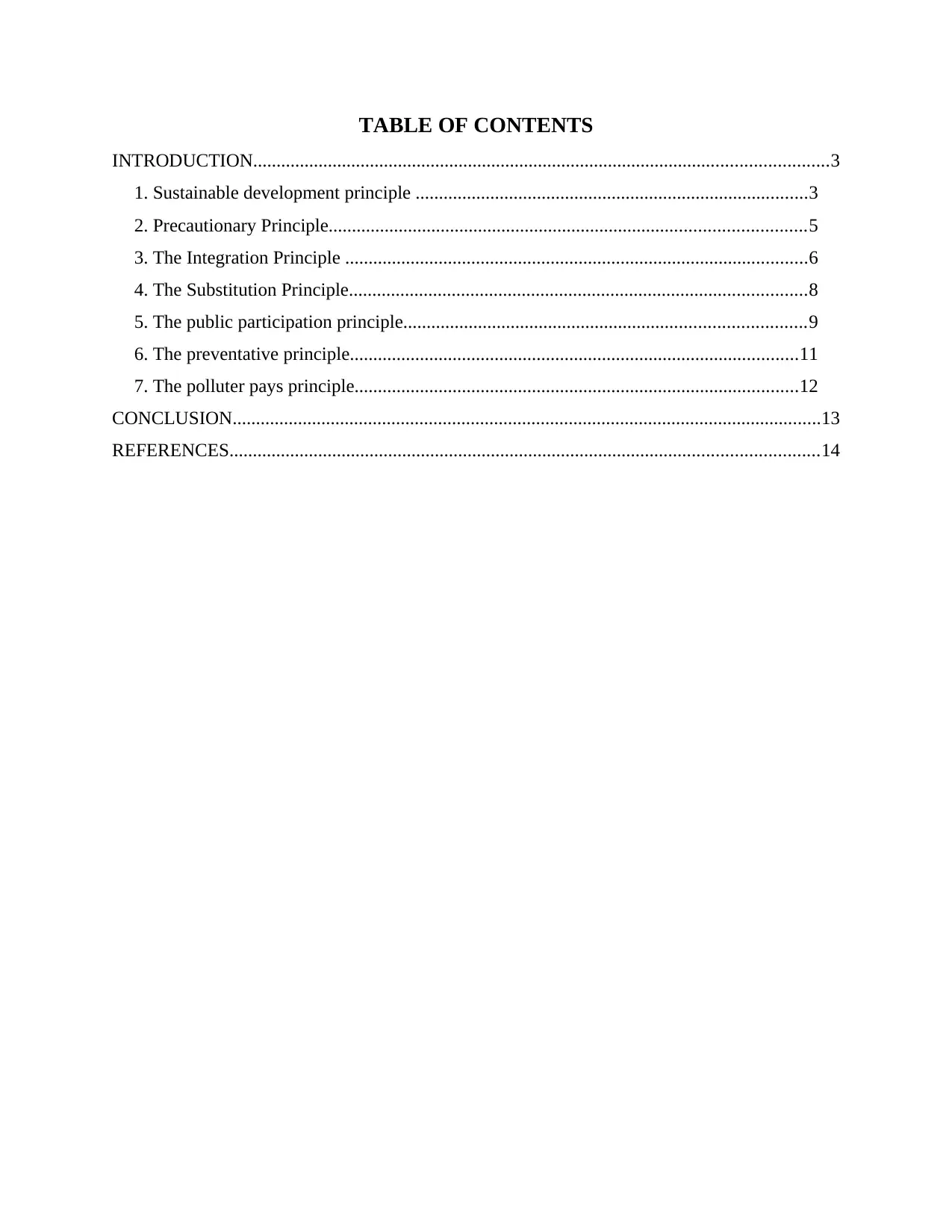
TABLE OF CONTENTS
INTRODUCTION...........................................................................................................................3
1. Sustainable development principle ....................................................................................3
2. Precautionary Principle......................................................................................................5
3. The Integration Principle ...................................................................................................6
4. The Substitution Principle..................................................................................................8
5. The public participation principle......................................................................................9
6. The preventative principle................................................................................................11
7. The polluter pays principle...............................................................................................12
CONCLUSION..............................................................................................................................13
REFERENCES..............................................................................................................................14
INTRODUCTION...........................................................................................................................3
1. Sustainable development principle ....................................................................................3
2. Precautionary Principle......................................................................................................5
3. The Integration Principle ...................................................................................................6
4. The Substitution Principle..................................................................................................8
5. The public participation principle......................................................................................9
6. The preventative principle................................................................................................11
7. The polluter pays principle...............................................................................................12
CONCLUSION..............................................................................................................................13
REFERENCES..............................................................................................................................14
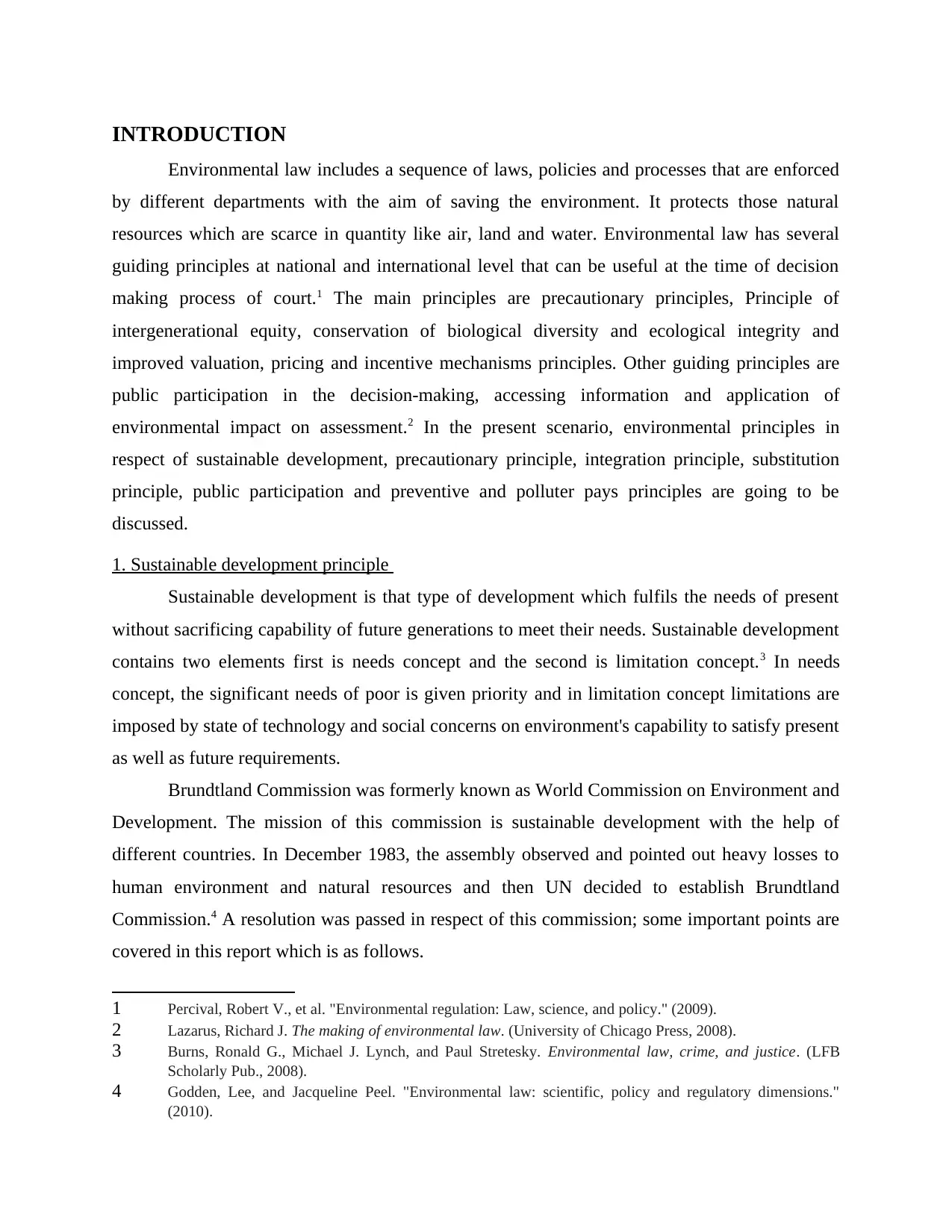
INTRODUCTION
Environmental law includes a sequence of laws, policies and processes that are enforced
by different departments with the aim of saving the environment. It protects those natural
resources which are scarce in quantity like air, land and water. Environmental law has several
guiding principles at national and international level that can be useful at the time of decision
making process of court.1 The main principles are precautionary principles, Principle of
intergenerational equity, conservation of biological diversity and ecological integrity and
improved valuation, pricing and incentive mechanisms principles. Other guiding principles are
public participation in the decision-making, accessing information and application of
environmental impact on assessment.2 In the present scenario, environmental principles in
respect of sustainable development, precautionary principle, integration principle, substitution
principle, public participation and preventive and polluter pays principles are going to be
discussed.
1. Sustainable development principle
Sustainable development is that type of development which fulfils the needs of present
without sacrificing capability of future generations to meet their needs. Sustainable development
contains two elements first is needs concept and the second is limitation concept.3 In needs
concept, the significant needs of poor is given priority and in limitation concept limitations are
imposed by state of technology and social concerns on environment's capability to satisfy present
as well as future requirements.
Brundtland Commission was formerly known as World Commission on Environment and
Development. The mission of this commission is sustainable development with the help of
different countries. In December 1983, the assembly observed and pointed out heavy losses to
human environment and natural resources and then UN decided to establish Brundtland
Commission.4 A resolution was passed in respect of this commission; some important points are
covered in this report which is as follows.
1 Percival, Robert V., et al. "Environmental regulation: Law, science, and policy." (2009).
2 Lazarus, Richard J. The making of environmental law. (University of Chicago Press, 2008).
3 Burns, Ronald G., Michael J. Lynch, and Paul Stretesky. Environmental law, crime, and justice. (LFB
Scholarly Pub., 2008).
4 Godden, Lee, and Jacqueline Peel. "Environmental law: scientific, policy and regulatory dimensions."
(2010).
Environmental law includes a sequence of laws, policies and processes that are enforced
by different departments with the aim of saving the environment. It protects those natural
resources which are scarce in quantity like air, land and water. Environmental law has several
guiding principles at national and international level that can be useful at the time of decision
making process of court.1 The main principles are precautionary principles, Principle of
intergenerational equity, conservation of biological diversity and ecological integrity and
improved valuation, pricing and incentive mechanisms principles. Other guiding principles are
public participation in the decision-making, accessing information and application of
environmental impact on assessment.2 In the present scenario, environmental principles in
respect of sustainable development, precautionary principle, integration principle, substitution
principle, public participation and preventive and polluter pays principles are going to be
discussed.
1. Sustainable development principle
Sustainable development is that type of development which fulfils the needs of present
without sacrificing capability of future generations to meet their needs. Sustainable development
contains two elements first is needs concept and the second is limitation concept.3 In needs
concept, the significant needs of poor is given priority and in limitation concept limitations are
imposed by state of technology and social concerns on environment's capability to satisfy present
as well as future requirements.
Brundtland Commission was formerly known as World Commission on Environment and
Development. The mission of this commission is sustainable development with the help of
different countries. In December 1983, the assembly observed and pointed out heavy losses to
human environment and natural resources and then UN decided to establish Brundtland
Commission.4 A resolution was passed in respect of this commission; some important points are
covered in this report which is as follows.
1 Percival, Robert V., et al. "Environmental regulation: Law, science, and policy." (2009).
2 Lazarus, Richard J. The making of environmental law. (University of Chicago Press, 2008).
3 Burns, Ronald G., Michael J. Lynch, and Paul Stretesky. Environmental law, crime, and justice. (LFB
Scholarly Pub., 2008).
4 Godden, Lee, and Jacqueline Peel. "Environmental law: scientific, policy and regulatory dimensions."
(2010).
⊘ This is a preview!⊘
Do you want full access?
Subscribe today to unlock all pages.

Trusted by 1+ million students worldwide
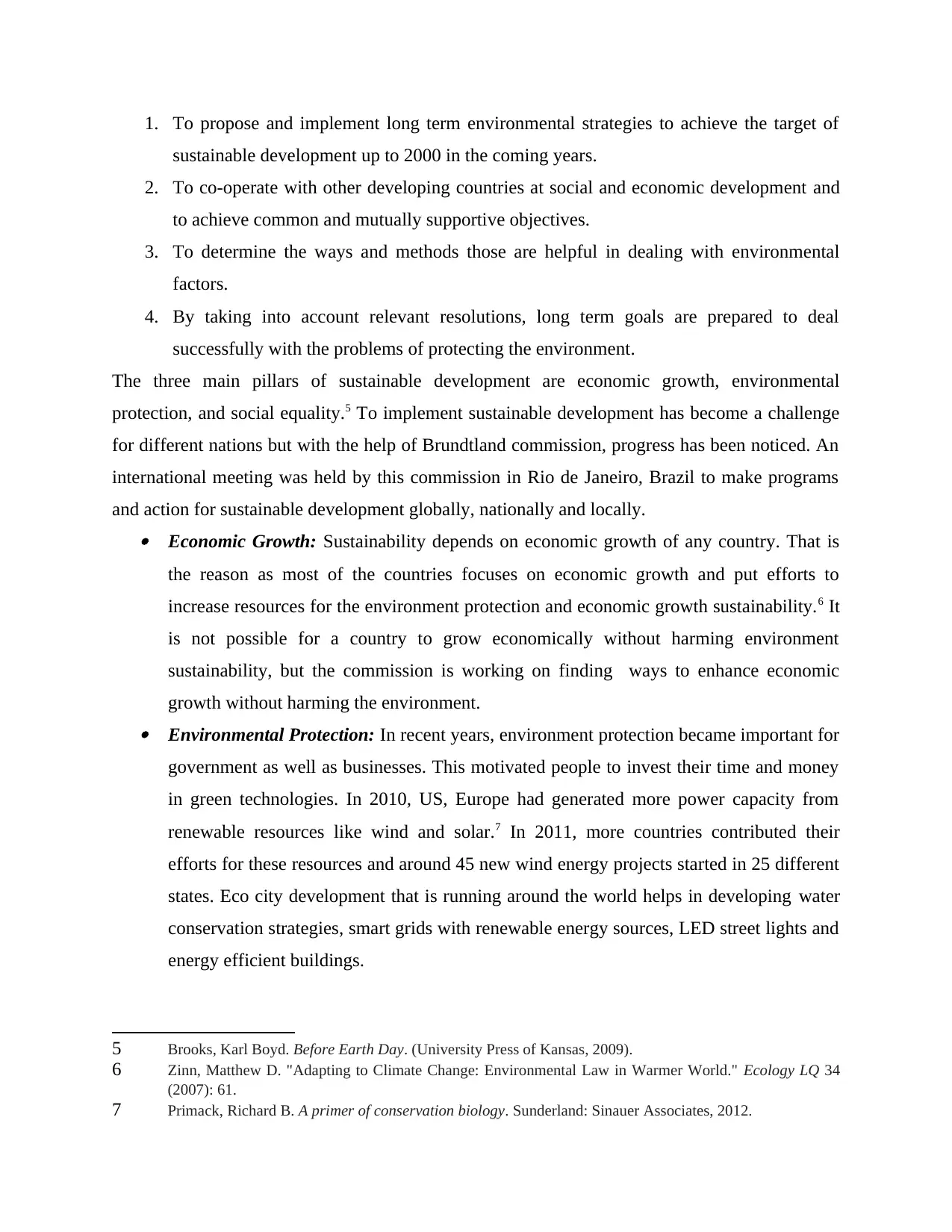
1. To propose and implement long term environmental strategies to achieve the target of
sustainable development up to 2000 in the coming years.
2. To co-operate with other developing countries at social and economic development and
to achieve common and mutually supportive objectives.
3. To determine the ways and methods those are helpful in dealing with environmental
factors.
4. By taking into account relevant resolutions, long term goals are prepared to deal
successfully with the problems of protecting the environment.
The three main pillars of sustainable development are economic growth, environmental
protection, and social equality.5 To implement sustainable development has become a challenge
for different nations but with the help of Brundtland commission, progress has been noticed. An
international meeting was held by this commission in Rio de Janeiro, Brazil to make programs
and action for sustainable development globally, nationally and locally. Economic Growth: Sustainability depends on economic growth of any country. That is
the reason as most of the countries focuses on economic growth and put efforts to
increase resources for the environment protection and economic growth sustainability.6 It
is not possible for a country to grow economically without harming environment
sustainability, but the commission is working on finding ways to enhance economic
growth without harming the environment. Environmental Protection: In recent years, environment protection became important for
government as well as businesses. This motivated people to invest their time and money
in green technologies. In 2010, US, Europe had generated more power capacity from
renewable resources like wind and solar.7 In 2011, more countries contributed their
efforts for these resources and around 45 new wind energy projects started in 25 different
states. Eco city development that is running around the world helps in developing water
conservation strategies, smart grids with renewable energy sources, LED street lights and
energy efficient buildings.
5 Brooks, Karl Boyd. Before Earth Day. (University Press of Kansas, 2009).
6 Zinn, Matthew D. "Adapting to Climate Change: Environmental Law in Warmer World." Ecology LQ 34
(2007): 61.
7 Primack, Richard B. A primer of conservation biology. Sunderland: Sinauer Associates, 2012.
sustainable development up to 2000 in the coming years.
2. To co-operate with other developing countries at social and economic development and
to achieve common and mutually supportive objectives.
3. To determine the ways and methods those are helpful in dealing with environmental
factors.
4. By taking into account relevant resolutions, long term goals are prepared to deal
successfully with the problems of protecting the environment.
The three main pillars of sustainable development are economic growth, environmental
protection, and social equality.5 To implement sustainable development has become a challenge
for different nations but with the help of Brundtland commission, progress has been noticed. An
international meeting was held by this commission in Rio de Janeiro, Brazil to make programs
and action for sustainable development globally, nationally and locally. Economic Growth: Sustainability depends on economic growth of any country. That is
the reason as most of the countries focuses on economic growth and put efforts to
increase resources for the environment protection and economic growth sustainability.6 It
is not possible for a country to grow economically without harming environment
sustainability, but the commission is working on finding ways to enhance economic
growth without harming the environment. Environmental Protection: In recent years, environment protection became important for
government as well as businesses. This motivated people to invest their time and money
in green technologies. In 2010, US, Europe had generated more power capacity from
renewable resources like wind and solar.7 In 2011, more countries contributed their
efforts for these resources and around 45 new wind energy projects started in 25 different
states. Eco city development that is running around the world helps in developing water
conservation strategies, smart grids with renewable energy sources, LED street lights and
energy efficient buildings.
5 Brooks, Karl Boyd. Before Earth Day. (University Press of Kansas, 2009).
6 Zinn, Matthew D. "Adapting to Climate Change: Environmental Law in Warmer World." Ecology LQ 34
(2007): 61.
7 Primack, Richard B. A primer of conservation biology. Sunderland: Sinauer Associates, 2012.
Paraphrase This Document
Need a fresh take? Get an instant paraphrase of this document with our AI Paraphraser
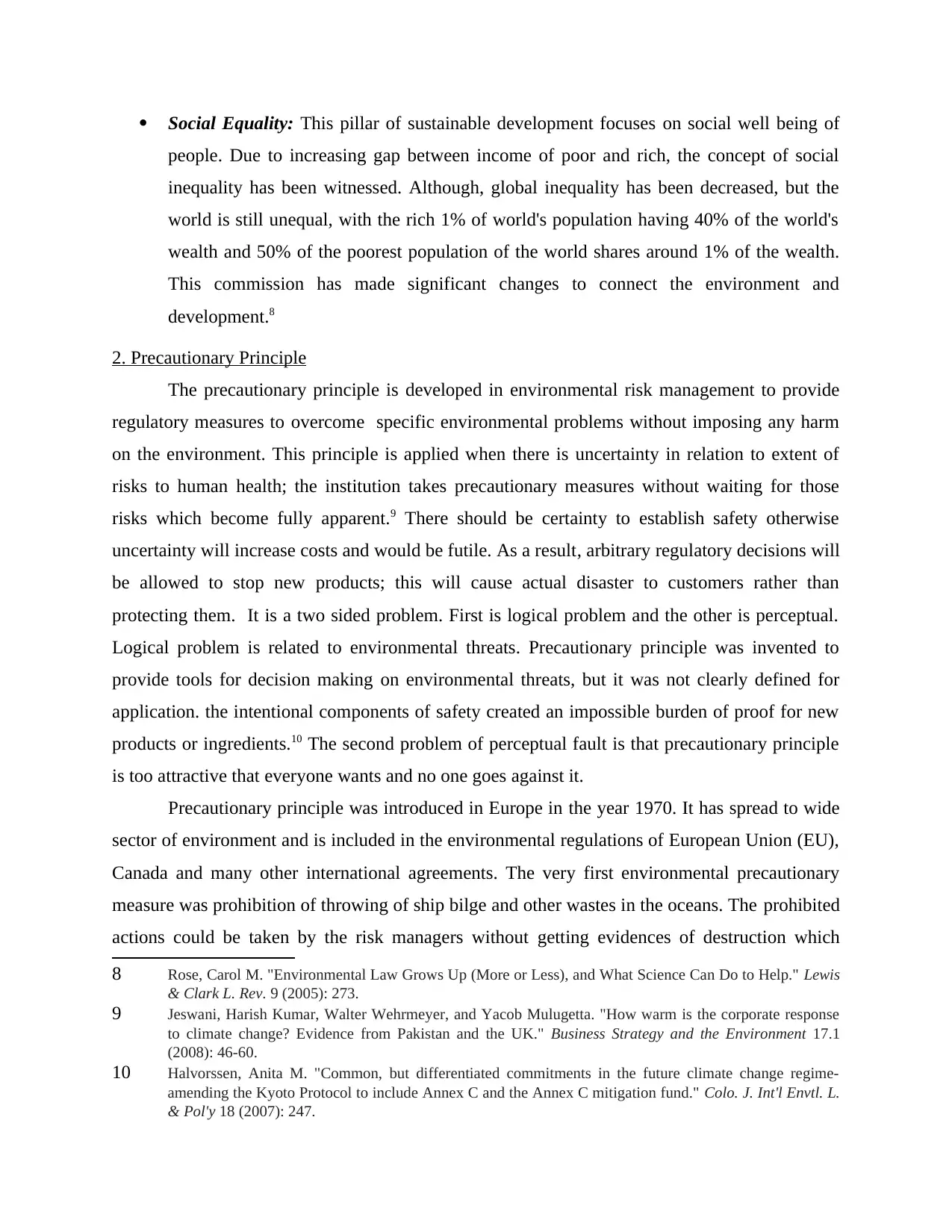
Social Equality: This pillar of sustainable development focuses on social well being of
people. Due to increasing gap between income of poor and rich, the concept of social
inequality has been witnessed. Although, global inequality has been decreased, but the
world is still unequal, with the rich 1% of world's population having 40% of the world's
wealth and 50% of the poorest population of the world shares around 1% of the wealth.
This commission has made significant changes to connect the environment and
development.8
2. Precautionary Principle
The precautionary principle is developed in environmental risk management to provide
regulatory measures to overcome specific environmental problems without imposing any harm
on the environment. This principle is applied when there is uncertainty in relation to extent of
risks to human health; the institution takes precautionary measures without waiting for those
risks which become fully apparent.9 There should be certainty to establish safety otherwise
uncertainty will increase costs and would be futile. As a result, arbitrary regulatory decisions will
be allowed to stop new products; this will cause actual disaster to customers rather than
protecting them. It is a two sided problem. First is logical problem and the other is perceptual.
Logical problem is related to environmental threats. Precautionary principle was invented to
provide tools for decision making on environmental threats, but it was not clearly defined for
application. the intentional components of safety created an impossible burden of proof for new
products or ingredients.10 The second problem of perceptual fault is that precautionary principle
is too attractive that everyone wants and no one goes against it.
Precautionary principle was introduced in Europe in the year 1970. It has spread to wide
sector of environment and is included in the environmental regulations of European Union (EU),
Canada and many other international agreements. The very first environmental precautionary
measure was prohibition of throwing of ship bilge and other wastes in the oceans. The prohibited
actions could be taken by the risk managers without getting evidences of destruction which
8 Rose, Carol M. "Environmental Law Grows Up (More or Less), and What Science Can Do to Help." Lewis
& Clark L. Rev. 9 (2005): 273.
9 Jeswani, Harish Kumar, Walter Wehrmeyer, and Yacob Mulugetta. "How warm is the corporate response
to climate change? Evidence from Pakistan and the UK." Business Strategy and the Environment 17.1
(2008): 46-60.
10 Halvorssen, Anita M. "Common, but differentiated commitments in the future climate change regime-
amending the Kyoto Protocol to include Annex C and the Annex C mitigation fund." Colo. J. Int'l Envtl. L.
& Pol'y 18 (2007): 247.
people. Due to increasing gap between income of poor and rich, the concept of social
inequality has been witnessed. Although, global inequality has been decreased, but the
world is still unequal, with the rich 1% of world's population having 40% of the world's
wealth and 50% of the poorest population of the world shares around 1% of the wealth.
This commission has made significant changes to connect the environment and
development.8
2. Precautionary Principle
The precautionary principle is developed in environmental risk management to provide
regulatory measures to overcome specific environmental problems without imposing any harm
on the environment. This principle is applied when there is uncertainty in relation to extent of
risks to human health; the institution takes precautionary measures without waiting for those
risks which become fully apparent.9 There should be certainty to establish safety otherwise
uncertainty will increase costs and would be futile. As a result, arbitrary regulatory decisions will
be allowed to stop new products; this will cause actual disaster to customers rather than
protecting them. It is a two sided problem. First is logical problem and the other is perceptual.
Logical problem is related to environmental threats. Precautionary principle was invented to
provide tools for decision making on environmental threats, but it was not clearly defined for
application. the intentional components of safety created an impossible burden of proof for new
products or ingredients.10 The second problem of perceptual fault is that precautionary principle
is too attractive that everyone wants and no one goes against it.
Precautionary principle was introduced in Europe in the year 1970. It has spread to wide
sector of environment and is included in the environmental regulations of European Union (EU),
Canada and many other international agreements. The very first environmental precautionary
measure was prohibition of throwing of ship bilge and other wastes in the oceans. The prohibited
actions could be taken by the risk managers without getting evidences of destruction which
8 Rose, Carol M. "Environmental Law Grows Up (More or Less), and What Science Can Do to Help." Lewis
& Clark L. Rev. 9 (2005): 273.
9 Jeswani, Harish Kumar, Walter Wehrmeyer, and Yacob Mulugetta. "How warm is the corporate response
to climate change? Evidence from Pakistan and the UK." Business Strategy and the Environment 17.1
(2008): 46-60.
10 Halvorssen, Anita M. "Common, but differentiated commitments in the future climate change regime-
amending the Kyoto Protocol to include Annex C and the Annex C mitigation fund." Colo. J. Int'l Envtl. L.
& Pol'y 18 (2007): 247.
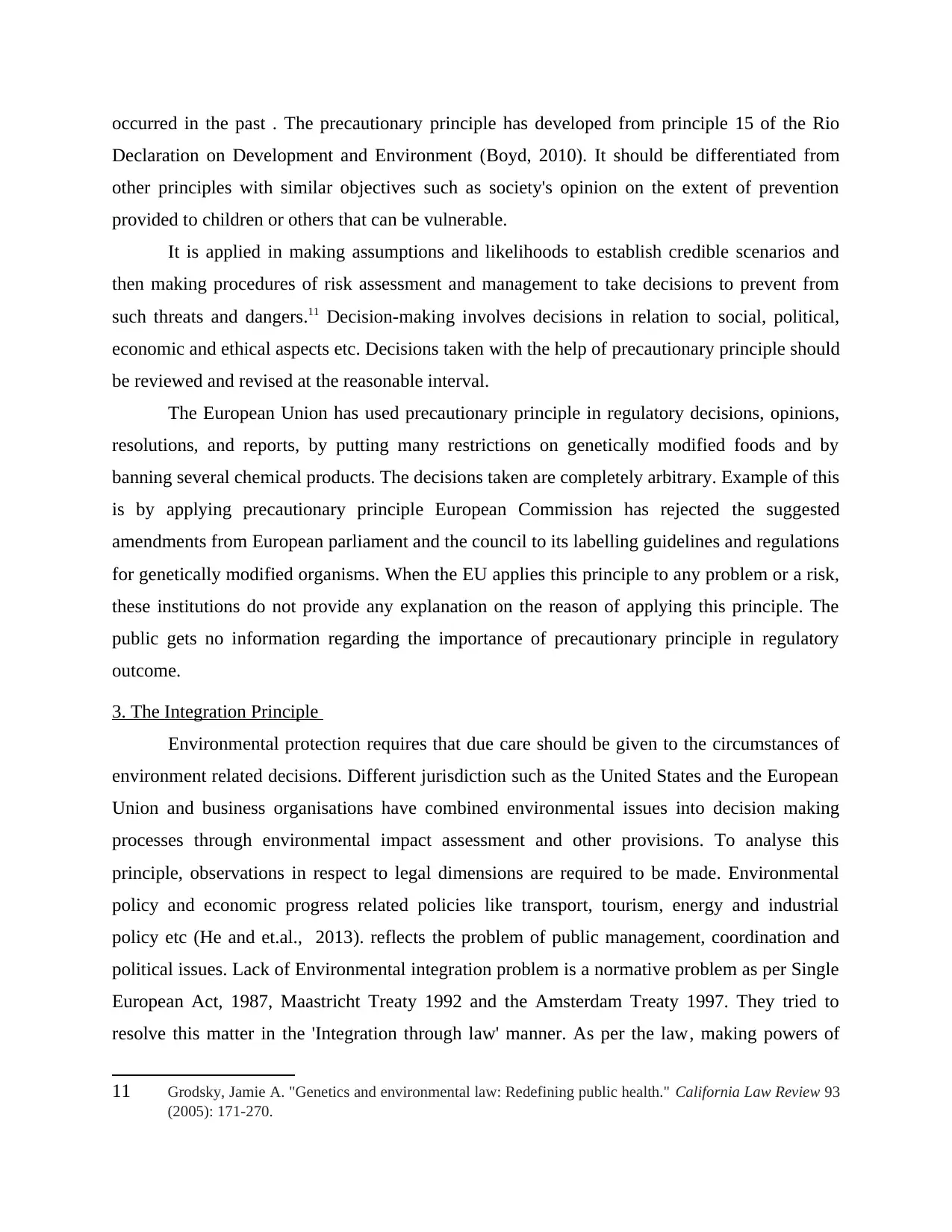
occurred in the past . The precautionary principle has developed from principle 15 of the Rio
Declaration on Development and Environment (Boyd, 2010). It should be differentiated from
other principles with similar objectives such as society's opinion on the extent of prevention
provided to children or others that can be vulnerable.
It is applied in making assumptions and likelihoods to establish credible scenarios and
then making procedures of risk assessment and management to take decisions to prevent from
such threats and dangers.11 Decision-making involves decisions in relation to social, political,
economic and ethical aspects etc. Decisions taken with the help of precautionary principle should
be reviewed and revised at the reasonable interval.
The European Union has used precautionary principle in regulatory decisions, opinions,
resolutions, and reports, by putting many restrictions on genetically modified foods and by
banning several chemical products. The decisions taken are completely arbitrary. Example of this
is by applying precautionary principle European Commission has rejected the suggested
amendments from European parliament and the council to its labelling guidelines and regulations
for genetically modified organisms. When the EU applies this principle to any problem or a risk,
these institutions do not provide any explanation on the reason of applying this principle. The
public gets no information regarding the importance of precautionary principle in regulatory
outcome.
3. The Integration Principle
Environmental protection requires that due care should be given to the circumstances of
environment related decisions. Different jurisdiction such as the United States and the European
Union and business organisations have combined environmental issues into decision making
processes through environmental impact assessment and other provisions. To analyse this
principle, observations in respect to legal dimensions are required to be made. Environmental
policy and economic progress related policies like transport, tourism, energy and industrial
policy etc (He and et.al., 2013). reflects the problem of public management, coordination and
political issues. Lack of Environmental integration problem is a normative problem as per Single
European Act, 1987, Maastricht Treaty 1992 and the Amsterdam Treaty 1997. They tried to
resolve this matter in the 'Integration through law' manner. As per the law, making powers of
11 Grodsky, Jamie A. "Genetics and environmental law: Redefining public health." California Law Review 93
(2005): 171-270.
Declaration on Development and Environment (Boyd, 2010). It should be differentiated from
other principles with similar objectives such as society's opinion on the extent of prevention
provided to children or others that can be vulnerable.
It is applied in making assumptions and likelihoods to establish credible scenarios and
then making procedures of risk assessment and management to take decisions to prevent from
such threats and dangers.11 Decision-making involves decisions in relation to social, political,
economic and ethical aspects etc. Decisions taken with the help of precautionary principle should
be reviewed and revised at the reasonable interval.
The European Union has used precautionary principle in regulatory decisions, opinions,
resolutions, and reports, by putting many restrictions on genetically modified foods and by
banning several chemical products. The decisions taken are completely arbitrary. Example of this
is by applying precautionary principle European Commission has rejected the suggested
amendments from European parliament and the council to its labelling guidelines and regulations
for genetically modified organisms. When the EU applies this principle to any problem or a risk,
these institutions do not provide any explanation on the reason of applying this principle. The
public gets no information regarding the importance of precautionary principle in regulatory
outcome.
3. The Integration Principle
Environmental protection requires that due care should be given to the circumstances of
environment related decisions. Different jurisdiction such as the United States and the European
Union and business organisations have combined environmental issues into decision making
processes through environmental impact assessment and other provisions. To analyse this
principle, observations in respect to legal dimensions are required to be made. Environmental
policy and economic progress related policies like transport, tourism, energy and industrial
policy etc (He and et.al., 2013). reflects the problem of public management, coordination and
political issues. Lack of Environmental integration problem is a normative problem as per Single
European Act, 1987, Maastricht Treaty 1992 and the Amsterdam Treaty 1997. They tried to
resolve this matter in the 'Integration through law' manner. As per the law, making powers of
11 Grodsky, Jamie A. "Genetics and environmental law: Redefining public health." California Law Review 93
(2005): 171-270.
⊘ This is a preview!⊘
Do you want full access?
Subscribe today to unlock all pages.

Trusted by 1+ million students worldwide
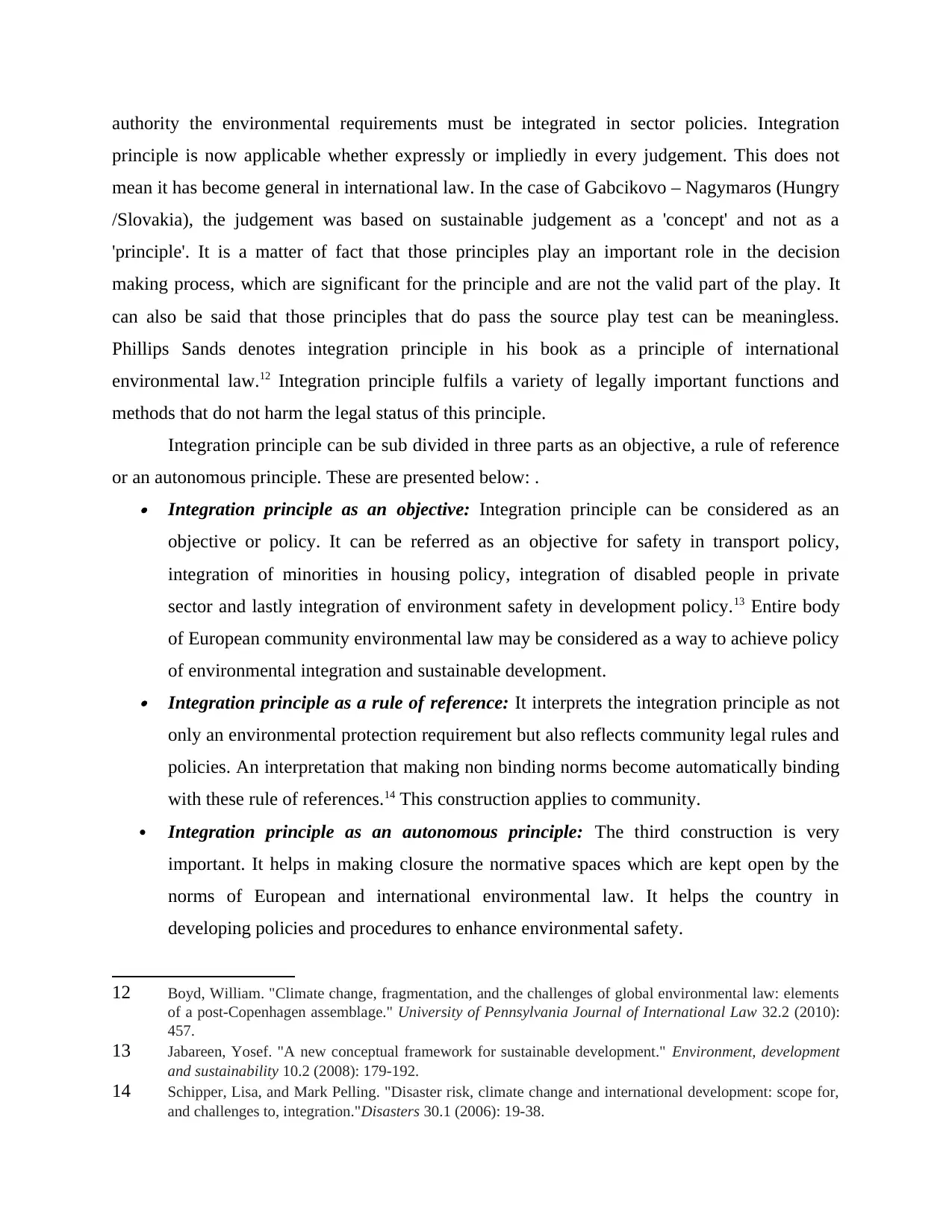
authority the environmental requirements must be integrated in sector policies. Integration
principle is now applicable whether expressly or impliedly in every judgement. This does not
mean it has become general in international law. In the case of Gabcikovo – Nagymaros (Hungry
/Slovakia), the judgement was based on sustainable judgement as a 'concept' and not as a
'principle'. It is a matter of fact that those principles play an important role in the decision
making process, which are significant for the principle and are not the valid part of the play. It
can also be said that those principles that do pass the source play test can be meaningless.
Phillips Sands denotes integration principle in his book as a principle of international
environmental law.12 Integration principle fulfils a variety of legally important functions and
methods that do not harm the legal status of this principle.
Integration principle can be sub divided in three parts as an objective, a rule of reference
or an autonomous principle. These are presented below: . Integration principle as an objective: Integration principle can be considered as an
objective or policy. It can be referred as an objective for safety in transport policy,
integration of minorities in housing policy, integration of disabled people in private
sector and lastly integration of environment safety in development policy.13 Entire body
of European community environmental law may be considered as a way to achieve policy
of environmental integration and sustainable development. Integration principle as a rule of reference: It interprets the integration principle as not
only an environmental protection requirement but also reflects community legal rules and
policies. An interpretation that making non binding norms become automatically binding
with these rule of references.14 This construction applies to community.
Integration principle as an autonomous principle: The third construction is very
important. It helps in making closure the normative spaces which are kept open by the
norms of European and international environmental law. It helps the country in
developing policies and procedures to enhance environmental safety.
12 Boyd, William. "Climate change, fragmentation, and the challenges of global environmental law: elements
of a post-Copenhagen assemblage." University of Pennsylvania Journal of International Law 32.2 (2010):
457.
13 Jabareen, Yosef. "A new conceptual framework for sustainable development." Environment, development
and sustainability 10.2 (2008): 179-192.
14 Schipper, Lisa, and Mark Pelling. "Disaster risk, climate change and international development: scope for,
and challenges to, integration."Disasters 30.1 (2006): 19-38.
principle is now applicable whether expressly or impliedly in every judgement. This does not
mean it has become general in international law. In the case of Gabcikovo – Nagymaros (Hungry
/Slovakia), the judgement was based on sustainable judgement as a 'concept' and not as a
'principle'. It is a matter of fact that those principles play an important role in the decision
making process, which are significant for the principle and are not the valid part of the play. It
can also be said that those principles that do pass the source play test can be meaningless.
Phillips Sands denotes integration principle in his book as a principle of international
environmental law.12 Integration principle fulfils a variety of legally important functions and
methods that do not harm the legal status of this principle.
Integration principle can be sub divided in three parts as an objective, a rule of reference
or an autonomous principle. These are presented below: . Integration principle as an objective: Integration principle can be considered as an
objective or policy. It can be referred as an objective for safety in transport policy,
integration of minorities in housing policy, integration of disabled people in private
sector and lastly integration of environment safety in development policy.13 Entire body
of European community environmental law may be considered as a way to achieve policy
of environmental integration and sustainable development. Integration principle as a rule of reference: It interprets the integration principle as not
only an environmental protection requirement but also reflects community legal rules and
policies. An interpretation that making non binding norms become automatically binding
with these rule of references.14 This construction applies to community.
Integration principle as an autonomous principle: The third construction is very
important. It helps in making closure the normative spaces which are kept open by the
norms of European and international environmental law. It helps the country in
developing policies and procedures to enhance environmental safety.
12 Boyd, William. "Climate change, fragmentation, and the challenges of global environmental law: elements
of a post-Copenhagen assemblage." University of Pennsylvania Journal of International Law 32.2 (2010):
457.
13 Jabareen, Yosef. "A new conceptual framework for sustainable development." Environment, development
and sustainability 10.2 (2008): 179-192.
14 Schipper, Lisa, and Mark Pelling. "Disaster risk, climate change and international development: scope for,
and challenges to, integration."Disasters 30.1 (2006): 19-38.
Paraphrase This Document
Need a fresh take? Get an instant paraphrase of this document with our AI Paraphraser
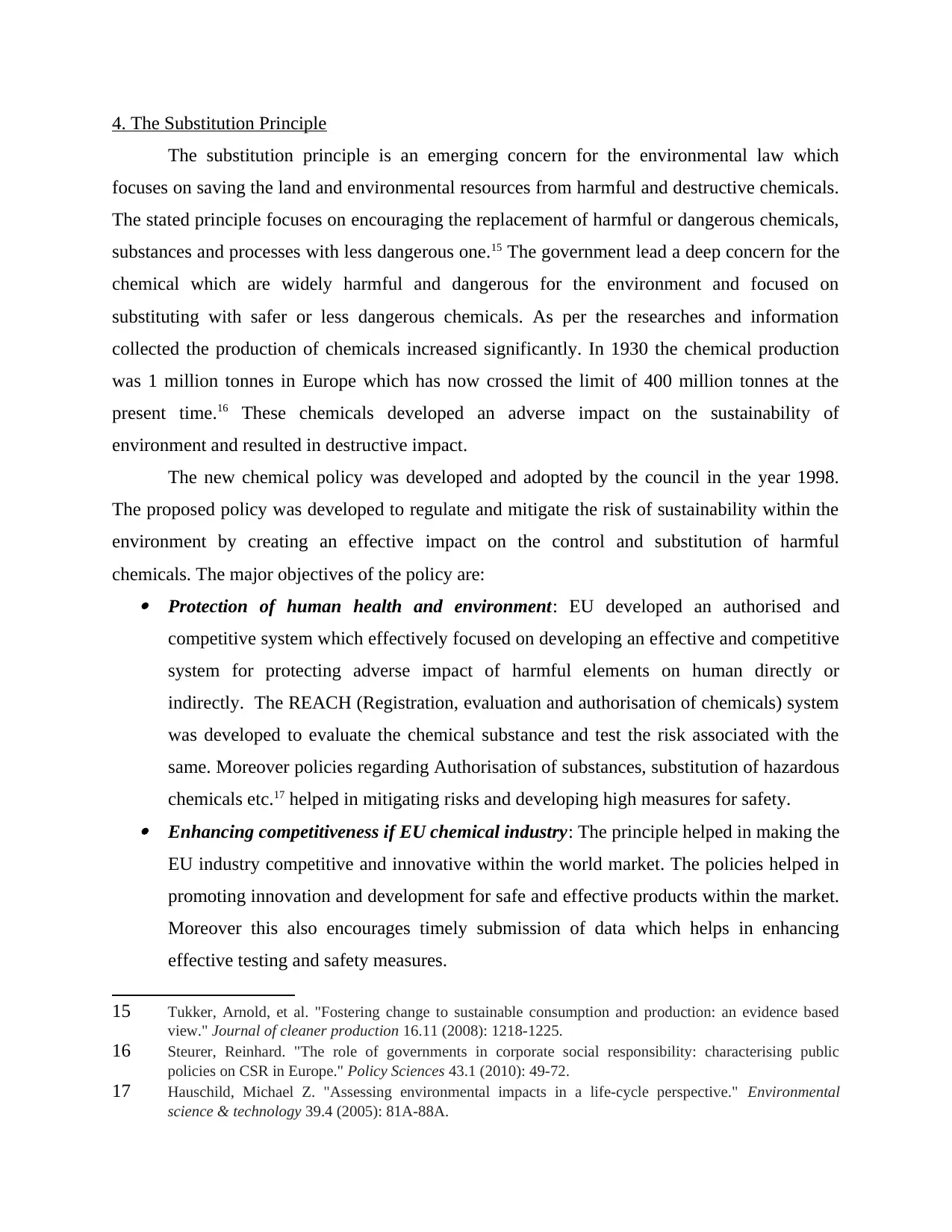
4. The Substitution Principle
The substitution principle is an emerging concern for the environmental law which
focuses on saving the land and environmental resources from harmful and destructive chemicals.
The stated principle focuses on encouraging the replacement of harmful or dangerous chemicals,
substances and processes with less dangerous one.15 The government lead a deep concern for the
chemical which are widely harmful and dangerous for the environment and focused on
substituting with safer or less dangerous chemicals. As per the researches and information
collected the production of chemicals increased significantly. In 1930 the chemical production
was 1 million tonnes in Europe which has now crossed the limit of 400 million tonnes at the
present time.16 These chemicals developed an adverse impact on the sustainability of
environment and resulted in destructive impact.
The new chemical policy was developed and adopted by the council in the year 1998.
The proposed policy was developed to regulate and mitigate the risk of sustainability within the
environment by creating an effective impact on the control and substitution of harmful
chemicals. The major objectives of the policy are: Protection of human health and environment: EU developed an authorised and
competitive system which effectively focused on developing an effective and competitive
system for protecting adverse impact of harmful elements on human directly or
indirectly. The REACH (Registration, evaluation and authorisation of chemicals) system
was developed to evaluate the chemical substance and test the risk associated with the
same. Moreover policies regarding Authorisation of substances, substitution of hazardous
chemicals etc.17 helped in mitigating risks and developing high measures for safety. Enhancing competitiveness if EU chemical industry: The principle helped in making the
EU industry competitive and innovative within the world market. The policies helped in
promoting innovation and development for safe and effective products within the market.
Moreover this also encourages timely submission of data which helps in enhancing
effective testing and safety measures.
15 Tukker, Arnold, et al. "Fostering change to sustainable consumption and production: an evidence based
view." Journal of cleaner production 16.11 (2008): 1218-1225.
16 Steurer, Reinhard. "The role of governments in corporate social responsibility: characterising public
policies on CSR in Europe." Policy Sciences 43.1 (2010): 49-72.
17 Hauschild, Michael Z. "Assessing environmental impacts in a life-cycle perspective." Environmental
science & technology 39.4 (2005): 81A-88A.
The substitution principle is an emerging concern for the environmental law which
focuses on saving the land and environmental resources from harmful and destructive chemicals.
The stated principle focuses on encouraging the replacement of harmful or dangerous chemicals,
substances and processes with less dangerous one.15 The government lead a deep concern for the
chemical which are widely harmful and dangerous for the environment and focused on
substituting with safer or less dangerous chemicals. As per the researches and information
collected the production of chemicals increased significantly. In 1930 the chemical production
was 1 million tonnes in Europe which has now crossed the limit of 400 million tonnes at the
present time.16 These chemicals developed an adverse impact on the sustainability of
environment and resulted in destructive impact.
The new chemical policy was developed and adopted by the council in the year 1998.
The proposed policy was developed to regulate and mitigate the risk of sustainability within the
environment by creating an effective impact on the control and substitution of harmful
chemicals. The major objectives of the policy are: Protection of human health and environment: EU developed an authorised and
competitive system which effectively focused on developing an effective and competitive
system for protecting adverse impact of harmful elements on human directly or
indirectly. The REACH (Registration, evaluation and authorisation of chemicals) system
was developed to evaluate the chemical substance and test the risk associated with the
same. Moreover policies regarding Authorisation of substances, substitution of hazardous
chemicals etc.17 helped in mitigating risks and developing high measures for safety. Enhancing competitiveness if EU chemical industry: The principle helped in making the
EU industry competitive and innovative within the world market. The policies helped in
promoting innovation and development for safe and effective products within the market.
Moreover this also encourages timely submission of data which helps in enhancing
effective testing and safety measures.
15 Tukker, Arnold, et al. "Fostering change to sustainable consumption and production: an evidence based
view." Journal of cleaner production 16.11 (2008): 1218-1225.
16 Steurer, Reinhard. "The role of governments in corporate social responsibility: characterising public
policies on CSR in Europe." Policy Sciences 43.1 (2010): 49-72.
17 Hauschild, Michael Z. "Assessing environmental impacts in a life-cycle perspective." Environmental
science & technology 39.4 (2005): 81A-88A.
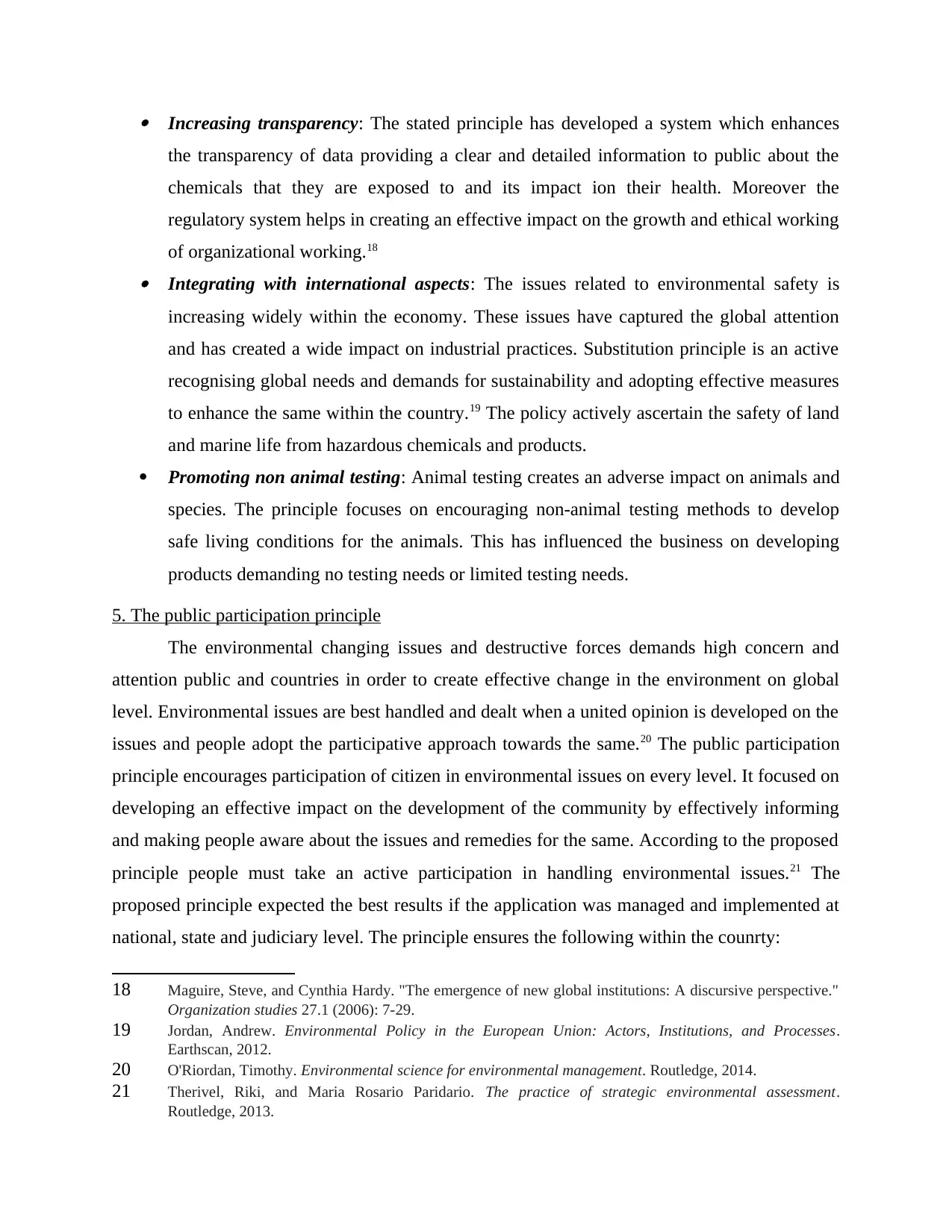
Increasing transparency: The stated principle has developed a system which enhances
the transparency of data providing a clear and detailed information to public about the
chemicals that they are exposed to and its impact ion their health. Moreover the
regulatory system helps in creating an effective impact on the growth and ethical working
of organizational working.18 Integrating with international aspects: The issues related to environmental safety is
increasing widely within the economy. These issues have captured the global attention
and has created a wide impact on industrial practices. Substitution principle is an active
recognising global needs and demands for sustainability and adopting effective measures
to enhance the same within the country.19 The policy actively ascertain the safety of land
and marine life from hazardous chemicals and products.
Promoting non animal testing: Animal testing creates an adverse impact on animals and
species. The principle focuses on encouraging non-animal testing methods to develop
safe living conditions for the animals. This has influenced the business on developing
products demanding no testing needs or limited testing needs.
5. The public participation principle
The environmental changing issues and destructive forces demands high concern and
attention public and countries in order to create effective change in the environment on global
level. Environmental issues are best handled and dealt when a united opinion is developed on the
issues and people adopt the participative approach towards the same.20 The public participation
principle encourages participation of citizen in environmental issues on every level. It focused on
developing an effective impact on the development of the community by effectively informing
and making people aware about the issues and remedies for the same. According to the proposed
principle people must take an active participation in handling environmental issues.21 The
proposed principle expected the best results if the application was managed and implemented at
national, state and judiciary level. The principle ensures the following within the counrty:
18 Maguire, Steve, and Cynthia Hardy. "The emergence of new global institutions: A discursive perspective."
Organization studies 27.1 (2006): 7-29.
19 Jordan, Andrew. Environmental Policy in the European Union: Actors, Institutions, and Processes.
Earthscan, 2012.
20 O'Riordan, Timothy. Environmental science for environmental management. Routledge, 2014.
21 Therivel, Riki, and Maria Rosario Paridario. The practice of strategic environmental assessment.
Routledge, 2013.
the transparency of data providing a clear and detailed information to public about the
chemicals that they are exposed to and its impact ion their health. Moreover the
regulatory system helps in creating an effective impact on the growth and ethical working
of organizational working.18 Integrating with international aspects: The issues related to environmental safety is
increasing widely within the economy. These issues have captured the global attention
and has created a wide impact on industrial practices. Substitution principle is an active
recognising global needs and demands for sustainability and adopting effective measures
to enhance the same within the country.19 The policy actively ascertain the safety of land
and marine life from hazardous chemicals and products.
Promoting non animal testing: Animal testing creates an adverse impact on animals and
species. The principle focuses on encouraging non-animal testing methods to develop
safe living conditions for the animals. This has influenced the business on developing
products demanding no testing needs or limited testing needs.
5. The public participation principle
The environmental changing issues and destructive forces demands high concern and
attention public and countries in order to create effective change in the environment on global
level. Environmental issues are best handled and dealt when a united opinion is developed on the
issues and people adopt the participative approach towards the same.20 The public participation
principle encourages participation of citizen in environmental issues on every level. It focused on
developing an effective impact on the development of the community by effectively informing
and making people aware about the issues and remedies for the same. According to the proposed
principle people must take an active participation in handling environmental issues.21 The
proposed principle expected the best results if the application was managed and implemented at
national, state and judiciary level. The principle ensures the following within the counrty:
18 Maguire, Steve, and Cynthia Hardy. "The emergence of new global institutions: A discursive perspective."
Organization studies 27.1 (2006): 7-29.
19 Jordan, Andrew. Environmental Policy in the European Union: Actors, Institutions, and Processes.
Earthscan, 2012.
20 O'Riordan, Timothy. Environmental science for environmental management. Routledge, 2014.
21 Therivel, Riki, and Maria Rosario Paridario. The practice of strategic environmental assessment.
Routledge, 2013.
⊘ This is a preview!⊘
Do you want full access?
Subscribe today to unlock all pages.

Trusted by 1+ million students worldwide
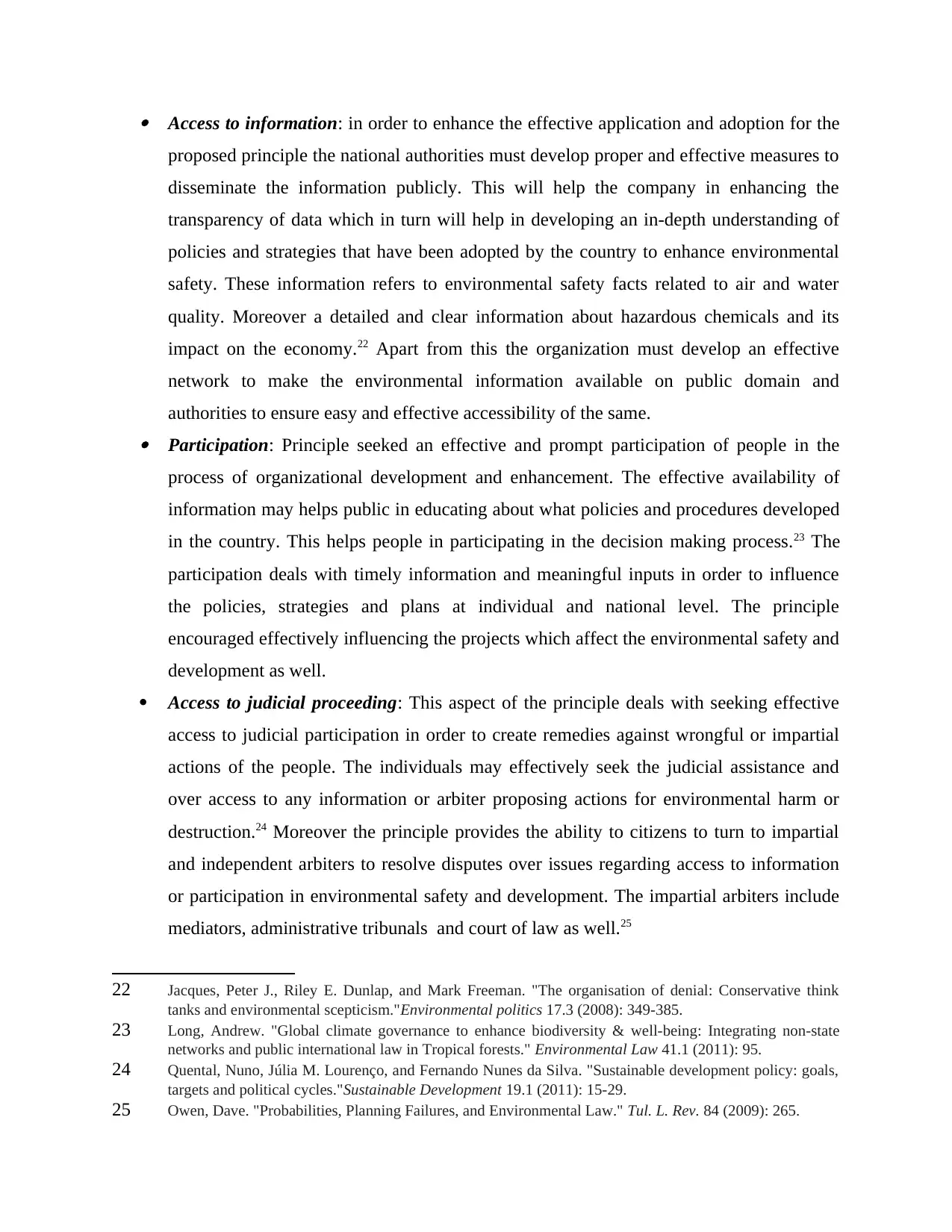
Access to information: in order to enhance the effective application and adoption for the
proposed principle the national authorities must develop proper and effective measures to
disseminate the information publicly. This will help the company in enhancing the
transparency of data which in turn will help in developing an in-depth understanding of
policies and strategies that have been adopted by the country to enhance environmental
safety. These information refers to environmental safety facts related to air and water
quality. Moreover a detailed and clear information about hazardous chemicals and its
impact on the economy.22 Apart from this the organization must develop an effective
network to make the environmental information available on public domain and
authorities to ensure easy and effective accessibility of the same. Participation: Principle seeked an effective and prompt participation of people in the
process of organizational development and enhancement. The effective availability of
information may helps public in educating about what policies and procedures developed
in the country. This helps people in participating in the decision making process.23 The
participation deals with timely information and meaningful inputs in order to influence
the policies, strategies and plans at individual and national level. The principle
encouraged effectively influencing the projects which affect the environmental safety and
development as well.
Access to judicial proceeding: This aspect of the principle deals with seeking effective
access to judicial participation in order to create remedies against wrongful or impartial
actions of the people. The individuals may effectively seek the judicial assistance and
over access to any information or arbiter proposing actions for environmental harm or
destruction.24 Moreover the principle provides the ability to citizens to turn to impartial
and independent arbiters to resolve disputes over issues regarding access to information
or participation in environmental safety and development. The impartial arbiters include
mediators, administrative tribunals and court of law as well.25
22 Jacques, Peter J., Riley E. Dunlap, and Mark Freeman. "The organisation of denial: Conservative think
tanks and environmental scepticism."Environmental politics 17.3 (2008): 349-385.
23 Long, Andrew. "Global climate governance to enhance biodiversity & well-being: Integrating non-state
networks and public international law in Tropical forests." Environmental Law 41.1 (2011): 95.
24 Quental, Nuno, Júlia M. Lourenço, and Fernando Nunes da Silva. "Sustainable development policy: goals,
targets and political cycles."Sustainable Development 19.1 (2011): 15-29.
25 Owen, Dave. "Probabilities, Planning Failures, and Environmental Law." Tul. L. Rev. 84 (2009): 265.
proposed principle the national authorities must develop proper and effective measures to
disseminate the information publicly. This will help the company in enhancing the
transparency of data which in turn will help in developing an in-depth understanding of
policies and strategies that have been adopted by the country to enhance environmental
safety. These information refers to environmental safety facts related to air and water
quality. Moreover a detailed and clear information about hazardous chemicals and its
impact on the economy.22 Apart from this the organization must develop an effective
network to make the environmental information available on public domain and
authorities to ensure easy and effective accessibility of the same. Participation: Principle seeked an effective and prompt participation of people in the
process of organizational development and enhancement. The effective availability of
information may helps public in educating about what policies and procedures developed
in the country. This helps people in participating in the decision making process.23 The
participation deals with timely information and meaningful inputs in order to influence
the policies, strategies and plans at individual and national level. The principle
encouraged effectively influencing the projects which affect the environmental safety and
development as well.
Access to judicial proceeding: This aspect of the principle deals with seeking effective
access to judicial participation in order to create remedies against wrongful or impartial
actions of the people. The individuals may effectively seek the judicial assistance and
over access to any information or arbiter proposing actions for environmental harm or
destruction.24 Moreover the principle provides the ability to citizens to turn to impartial
and independent arbiters to resolve disputes over issues regarding access to information
or participation in environmental safety and development. The impartial arbiters include
mediators, administrative tribunals and court of law as well.25
22 Jacques, Peter J., Riley E. Dunlap, and Mark Freeman. "The organisation of denial: Conservative think
tanks and environmental scepticism."Environmental politics 17.3 (2008): 349-385.
23 Long, Andrew. "Global climate governance to enhance biodiversity & well-being: Integrating non-state
networks and public international law in Tropical forests." Environmental Law 41.1 (2011): 95.
24 Quental, Nuno, Júlia M. Lourenço, and Fernando Nunes da Silva. "Sustainable development policy: goals,
targets and political cycles."Sustainable Development 19.1 (2011): 15-29.
25 Owen, Dave. "Probabilities, Planning Failures, and Environmental Law." Tul. L. Rev. 84 (2009): 265.
Paraphrase This Document
Need a fresh take? Get an instant paraphrase of this document with our AI Paraphraser
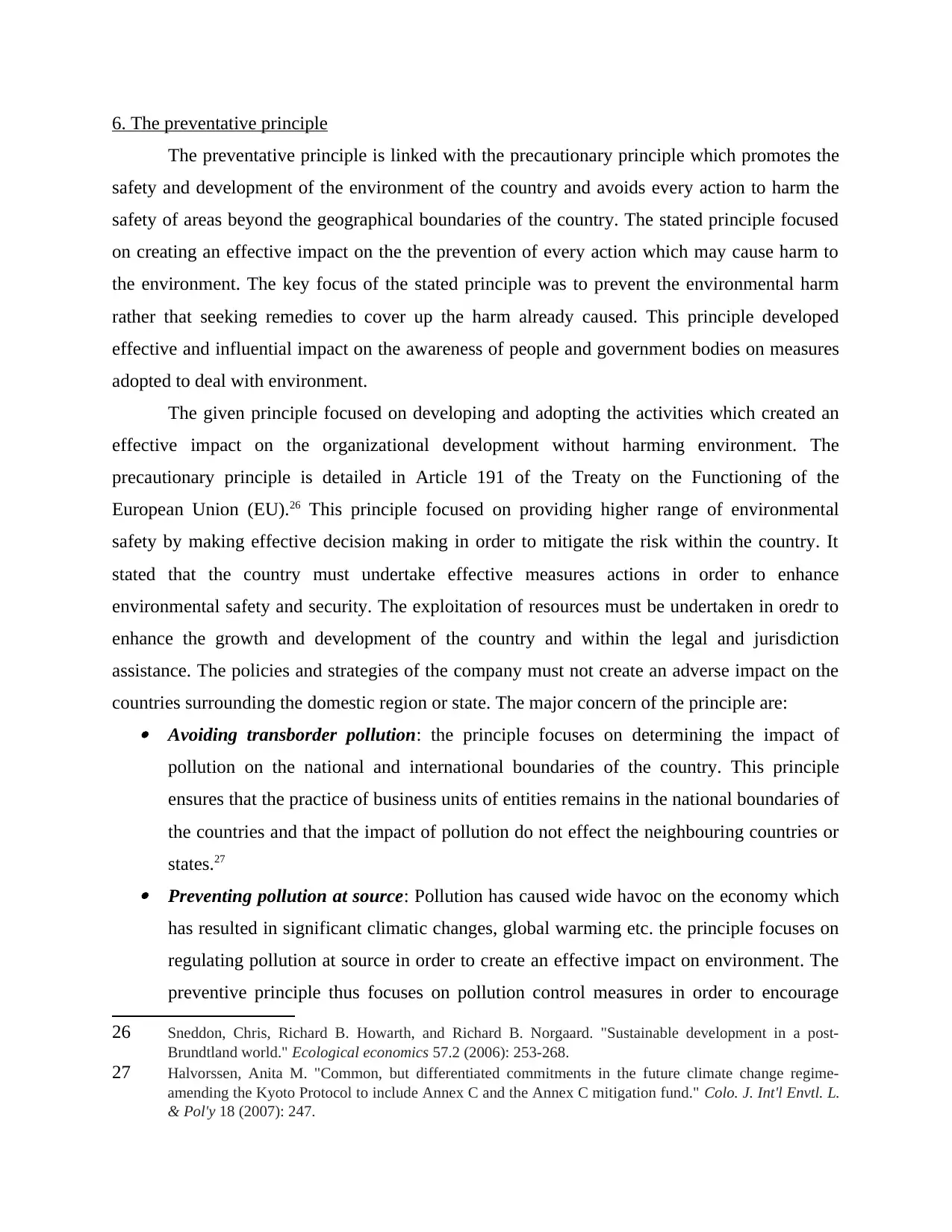
6. The preventative principle
The preventative principle is linked with the precautionary principle which promotes the
safety and development of the environment of the country and avoids every action to harm the
safety of areas beyond the geographical boundaries of the country. The stated principle focused
on creating an effective impact on the the prevention of every action which may cause harm to
the environment. The key focus of the stated principle was to prevent the environmental harm
rather that seeking remedies to cover up the harm already caused. This principle developed
effective and influential impact on the awareness of people and government bodies on measures
adopted to deal with environment.
The given principle focused on developing and adopting the activities which created an
effective impact on the organizational development without harming environment. The
precautionary principle is detailed in Article 191 of the Treaty on the Functioning of the
European Union (EU).26 This principle focused on providing higher range of environmental
safety by making effective decision making in order to mitigate the risk within the country. It
stated that the country must undertake effective measures actions in order to enhance
environmental safety and security. The exploitation of resources must be undertaken in oredr to
enhance the growth and development of the country and within the legal and jurisdiction
assistance. The policies and strategies of the company must not create an adverse impact on the
countries surrounding the domestic region or state. The major concern of the principle are: Avoiding transborder pollution: the principle focuses on determining the impact of
pollution on the national and international boundaries of the country. This principle
ensures that the practice of business units of entities remains in the national boundaries of
the countries and that the impact of pollution do not effect the neighbouring countries or
states.27 Preventing pollution at source: Pollution has caused wide havoc on the economy which
has resulted in significant climatic changes, global warming etc. the principle focuses on
regulating pollution at source in order to create an effective impact on environment. The
preventive principle thus focuses on pollution control measures in order to encourage
26 Sneddon, Chris, Richard B. Howarth, and Richard B. Norgaard. "Sustainable development in a post-
Brundtland world." Ecological economics 57.2 (2006): 253-268.
27 Halvorssen, Anita M. "Common, but differentiated commitments in the future climate change regime-
amending the Kyoto Protocol to include Annex C and the Annex C mitigation fund." Colo. J. Int'l Envtl. L.
& Pol'y 18 (2007): 247.
The preventative principle is linked with the precautionary principle which promotes the
safety and development of the environment of the country and avoids every action to harm the
safety of areas beyond the geographical boundaries of the country. The stated principle focused
on creating an effective impact on the the prevention of every action which may cause harm to
the environment. The key focus of the stated principle was to prevent the environmental harm
rather that seeking remedies to cover up the harm already caused. This principle developed
effective and influential impact on the awareness of people and government bodies on measures
adopted to deal with environment.
The given principle focused on developing and adopting the activities which created an
effective impact on the organizational development without harming environment. The
precautionary principle is detailed in Article 191 of the Treaty on the Functioning of the
European Union (EU).26 This principle focused on providing higher range of environmental
safety by making effective decision making in order to mitigate the risk within the country. It
stated that the country must undertake effective measures actions in order to enhance
environmental safety and security. The exploitation of resources must be undertaken in oredr to
enhance the growth and development of the country and within the legal and jurisdiction
assistance. The policies and strategies of the company must not create an adverse impact on the
countries surrounding the domestic region or state. The major concern of the principle are: Avoiding transborder pollution: the principle focuses on determining the impact of
pollution on the national and international boundaries of the country. This principle
ensures that the practice of business units of entities remains in the national boundaries of
the countries and that the impact of pollution do not effect the neighbouring countries or
states.27 Preventing pollution at source: Pollution has caused wide havoc on the economy which
has resulted in significant climatic changes, global warming etc. the principle focuses on
regulating pollution at source in order to create an effective impact on environment. The
preventive principle thus focuses on pollution control measures in order to encourage
26 Sneddon, Chris, Richard B. Howarth, and Richard B. Norgaard. "Sustainable development in a post-
Brundtland world." Ecological economics 57.2 (2006): 253-268.
27 Halvorssen, Anita M. "Common, but differentiated commitments in the future climate change regime-
amending the Kyoto Protocol to include Annex C and the Annex C mitigation fund." Colo. J. Int'l Envtl. L.
& Pol'y 18 (2007): 247.
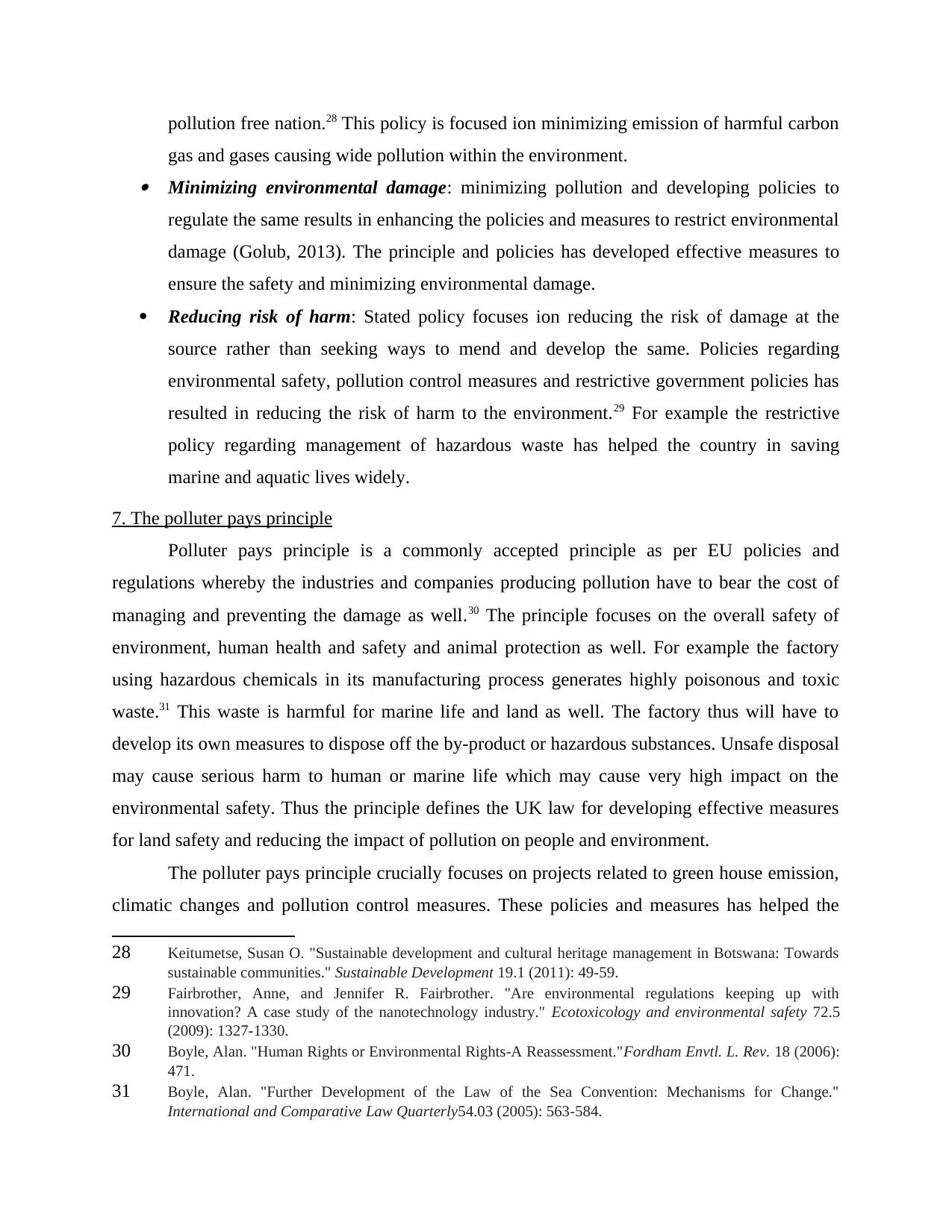
pollution free nation.28 This policy is focused ion minimizing emission of harmful carbon
gas and gases causing wide pollution within the environment. Minimizing environmental damage: minimizing pollution and developing policies to
regulate the same results in enhancing the policies and measures to restrict environmental
damage (Golub, 2013). The principle and policies has developed effective measures to
ensure the safety and minimizing environmental damage.
Reducing risk of harm: Stated policy focuses ion reducing the risk of damage at the
source rather than seeking ways to mend and develop the same. Policies regarding
environmental safety, pollution control measures and restrictive government policies has
resulted in reducing the risk of harm to the environment.29 For example the restrictive
policy regarding management of hazardous waste has helped the country in saving
marine and aquatic lives widely.
7. The polluter pays principle
Polluter pays principle is a commonly accepted principle as per EU policies and
regulations whereby the industries and companies producing pollution have to bear the cost of
managing and preventing the damage as well.30 The principle focuses on the overall safety of
environment, human health and safety and animal protection as well. For example the factory
using hazardous chemicals in its manufacturing process generates highly poisonous and toxic
waste.31 This waste is harmful for marine life and land as well. The factory thus will have to
develop its own measures to dispose off the by-product or hazardous substances. Unsafe disposal
may cause serious harm to human or marine life which may cause very high impact on the
environmental safety. Thus the principle defines the UK law for developing effective measures
for land safety and reducing the impact of pollution on people and environment.
The polluter pays principle crucially focuses on projects related to green house emission,
climatic changes and pollution control measures. These policies and measures has helped the
28 Keitumetse, Susan O. "Sustainable development and cultural heritage management in Botswana: Towards
sustainable communities." Sustainable Development 19.1 (2011): 49-59.
29 Fairbrother, Anne, and Jennifer R. Fairbrother. "Are environmental regulations keeping up with
innovation? A case study of the nanotechnology industry." Ecotoxicology and environmental safety 72.5
(2009): 1327-1330.
30 Boyle, Alan. "Human Rights or Environmental Rights-A Reassessment."Fordham Envtl. L. Rev. 18 (2006):
471.
31 Boyle, Alan. "Further Development of the Law of the Sea Convention: Mechanisms for Change."
International and Comparative Law Quarterly54.03 (2005): 563-584.
gas and gases causing wide pollution within the environment. Minimizing environmental damage: minimizing pollution and developing policies to
regulate the same results in enhancing the policies and measures to restrict environmental
damage (Golub, 2013). The principle and policies has developed effective measures to
ensure the safety and minimizing environmental damage.
Reducing risk of harm: Stated policy focuses ion reducing the risk of damage at the
source rather than seeking ways to mend and develop the same. Policies regarding
environmental safety, pollution control measures and restrictive government policies has
resulted in reducing the risk of harm to the environment.29 For example the restrictive
policy regarding management of hazardous waste has helped the country in saving
marine and aquatic lives widely.
7. The polluter pays principle
Polluter pays principle is a commonly accepted principle as per EU policies and
regulations whereby the industries and companies producing pollution have to bear the cost of
managing and preventing the damage as well.30 The principle focuses on the overall safety of
environment, human health and safety and animal protection as well. For example the factory
using hazardous chemicals in its manufacturing process generates highly poisonous and toxic
waste.31 This waste is harmful for marine life and land as well. The factory thus will have to
develop its own measures to dispose off the by-product or hazardous substances. Unsafe disposal
may cause serious harm to human or marine life which may cause very high impact on the
environmental safety. Thus the principle defines the UK law for developing effective measures
for land safety and reducing the impact of pollution on people and environment.
The polluter pays principle crucially focuses on projects related to green house emission,
climatic changes and pollution control measures. These policies and measures has helped the
28 Keitumetse, Susan O. "Sustainable development and cultural heritage management in Botswana: Towards
sustainable communities." Sustainable Development 19.1 (2011): 49-59.
29 Fairbrother, Anne, and Jennifer R. Fairbrother. "Are environmental regulations keeping up with
innovation? A case study of the nanotechnology industry." Ecotoxicology and environmental safety 72.5
(2009): 1327-1330.
30 Boyle, Alan. "Human Rights or Environmental Rights-A Reassessment."Fordham Envtl. L. Rev. 18 (2006):
471.
31 Boyle, Alan. "Further Development of the Law of the Sea Convention: Mechanisms for Change."
International and Comparative Law Quarterly54.03 (2005): 563-584.
⊘ This is a preview!⊘
Do you want full access?
Subscribe today to unlock all pages.

Trusted by 1+ million students worldwide
1 out of 15
Related Documents
Your All-in-One AI-Powered Toolkit for Academic Success.
+13062052269
info@desklib.com
Available 24*7 on WhatsApp / Email
![[object Object]](/_next/static/media/star-bottom.7253800d.svg)
Unlock your academic potential
Copyright © 2020–2025 A2Z Services. All Rights Reserved. Developed and managed by ZUCOL.





